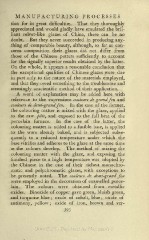Page 479 - Oriental Series Japan and China, Brinkly
P. 479
MANUFACTURING PROCESSES
tion for its great difficulties. That they thoroughly
appreciated and would gladly have emulated the bril-
liant velvet-like glazes of China, there can be no
doubt. But they never succeeded in producing any-
thing of comparable beauty, although, so far as con-
cerns composition their glazes did not differ from
those of the Chinese potters sufficiently to account
for the signally superior results obtained by the latter.
On the whole, it appears a reasonable conclusion that
the exceptional qualities of Chinese glazes were due
in part only to the nature of the materials employed,
and that they owed something to the troublesome and
seemingly unscientific method of their application.
A word of explanation may be added here with
reference to the expressions couleurs de grandfeu and
couleurs de demi-grandfeu. In the case of the former,
the colouring matter is mixed with the glaze, applied
to the raw pate, and exposed to the full heat of the
porcelain furnace. In the case of the latter, the
colouring matter is added to a fusible base, is applied
to the ware already baked, and is subjected subse-
quently to a reduced temperature under which the
base vitrifies and adheres to the glaze at the same time
as the colours develop. The method of mixing the
colouring matter with the glaze, and exposing the
finished piece to a high temperature was adopted by
the Chinese in the case of their richest monochro-
matic and polychromatic glazes, with exceptions to
be presently noted. The couleurs de demi-grand feu
were employed in the decoration of enamelled porce-
lain. The colours were obtained from metallic
oxides. Binoxide of copper gave green, bluish green,
and turquoise blue ; oxide of cobalt, blue oxide of
;
antimony, yellow ; oxide of iron, brown and ver-
393

